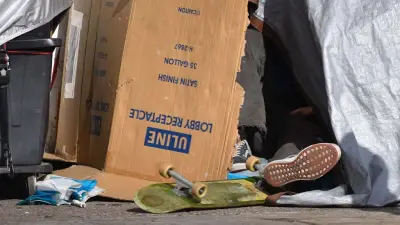El Cajon mayor disputes nearly 22% homelessness spike as ‘inflated’ and ‘inaccurate’

A homeless man rests between boxes Photo by Chris Stone Times of San Diego El Cajon Mayor Bill Wells stated Friday that the Regional Task Force on Homelessness annual Point-In-Time Count of people experiencing homelessness in the city was inflated and inaccurate The results of that count a one-day snapshot of the minimum number of people experiencing homelessness throughout the region distributed earlier this week detected a considerable increase in the number of people without stable housing in the East County city The only city to post a critical gain in both percentage and number of unhoused people was El Cajon where the number of unsheltered people alone increased from to a increase The county included individuals outside our city limits counted people they themselves placed into El Cajon hotels through their ineffective hotel voucher effort and tallied areas not even within our jurisdiction disclosed Wells who is running for re-election Our Homeless Outreach Association and supporters on the ground unveiled the numbers baffling and far higher than reality We believe there was likely double counting inflated estimates or miscounts by surveyors who never left their vehicles Wells blamed housing first policies at both the state and county level for the count a framework which believes getting people into housing first before remedy for mental illness or substance abuse is how to tackle homelessness He also disclosed the RTFH counted people living unsheltered on tracts of land not in the city limits as a reason for the numbers recorded We are a solutions-first city focused on therapy accountability and society safety not just warehousing people in hotels or ignoring the challenge entirely he announced El Cajon continues to lead with compassion and results We won t allow false numbers or failed policies to undermine our work or mislead our residents The annual countywide count uncovered the number of people experiencing homelessness dropped by and dropped by about in the city of San Diego The facts was collected in January during the Point-in-Time Count when more than helpers including site coordinators trained outreach workers and county staff hit the streets to speak to those living without stable housing The progress is certainly encouraging RTFH CEO Tamera Kohler reported The investments our region and cities have made are working especially as they relate to veterans family homelessness and those needing a little financial assistance I want to thank the elected leaders providers and other decision makers who have helped drive this change Kohler continued I also want to stress the obvious There s more work to do Too multiple people for example are living in their cars and while we are moving closer toward eliminating family and veteran homelessness we need more apartment owners and landlords willing to house people with assistance The helpers located no fewer than people experiencing homelessness throughout the county down from a year ago This year s records include unsheltered San Diegans and individuals in shelters and transitional housing The content show noteworthy reductions in several cities that saw their numbers fall due to a series of investments partnerships and utilization of best practices a message from the RTFH read Also down in numbers were Carlsbad by Encinitas by Oceanside and La Mesa by and Chula Vista down Last year s count identified the number of homeless increased by an estimated over the previous year and the figures stated a increase The number of homeless senior citizens who make up fully a third of those experiencing homelessness in the region increased by over the year Half of them became homeless for the first time The oldest person exposed unsheltered was an -year-old white male Last year it was an -year-old Hispanic woman The number of people living in vehicles also saw an increase of while the number of homeless transitional age youth - declined by The number of families living unsheltered dropped dramatically by and the number of veterans in the same situation also dropped by double-digits According to the U S Department of Housing and Urban Rise safe sleeping and safe parking sites count as being unsheltered In the annual count supporters ask demographic questions of people they find experiencing homelessness In s summary they began the reporting of Hispanic ethnicity along with race for the first time

